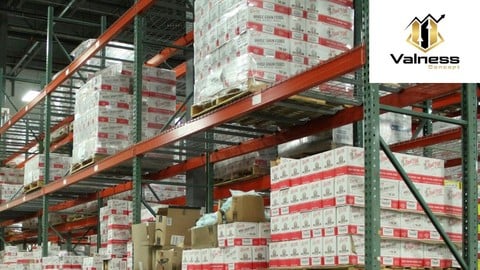Warehouse Management in Logistics & Supply Chain Management
Build Supply Chain Expertise with Real Strategies in Logistics, Inventory Control, Procurement & Warehouse Management
What you'll learn
- Understand end-to-end supply chain operations—from procurement to final delivery
- Optimize logistics, freight, and transport planning using real-world strategies
- Master inventory control systems (EOQ, JIT, ABC, FIFO/LIFO) and performance KPIs
- Improve warehouse design, automation, WMS usage, and sourcing decisions
- Analyze and select the most cost-effective transportation modes for different cargo types
- Build resilience in your supply chain with risk mitigation and demand forecasting techniques
- Conduct inventory audits and prevent losses from shrinkage, spoilage, or obsolescence
- Streamline warehouse operations—from receiving and storage to picking and shipping
- Evaluate supplier performance using appraisal metrics like quality, cost, and capacity
- Make smart make-or-buy decisions aligned with cost, capability, and business goals
- Execute efficient procurement processes, contract negotiations, and vendor management
- Apply sustainable sourcing and green logistics practices in modern supply chains
- Track and improve performance using supply chain KPIs and continuous improvement tools
- Align supply chain functions with strategic business objectives for maximum impact
- Leverage digital tools like ERP, RFID, and automation to modernize supply chain workflows
Description
Master the Core Pillars of Supply Chain Management—Logistics, Inventory & Warehousing
Unlock the skills and strategies you need to thrive in today’s fast-paced supply chain environment. Whether you're a logistics officer, warehouse manager, business owner, or aspiring supply chain professional, this course offers practical, job-ready knowledge in logistics, inventory control, and warehouse management.
You’ll gain hands-on understanding of the entire supply chain process—from sourcing and procurement to transportation planning and warehouse operations—while learning how to cut costs, improve efficiency, and implement modern technologies like WMS and RFID.
What You’ll Learn:
Understand the full supply chain lifecycle and its critical components
Break down the roles of procurement, logistics, inventory, and warehousing
Explore inbound, outbound, and reverse logistics and their real-world applications
Compare transportation modes (road, rail, air, sea, pipeline) and select cost-effective options
Master logistics planning, freight management, route optimization, and 3PL partnerships
Track logistics KPIs like on-time delivery, cost per shipment, and fulfillment rate
Implement inventory control systems: periodic vs. perpetual, FIFO, LIFO, bin systems
Calculate and apply EOQ, Reorder Point (ROP), Safety Stock, and Inventory Turnover
Use forecasting techniques (demand-driven, historical) to manage inventory needs
Apply ABC Analysis and Just-In-Time (JIT) inventory methods
Conduct stock audits and cycle counts to maintain inventory accuracy
Identify and reduce inventory losses (shrinkage, obsolescence, theft, spoilage)
Track inventory KPIs like carrying cost, fill rate, and stockout rate
Design efficient warehouse layouts that optimize space and material flow
Manage core warehouse processes: receiving, storing, picking, packing, and shipping
Select appropriate material handling equipment and ensure warehouse safety
Leverage warehouse technology including WMS, barcoding, and automation
Measure warehouse performance using key KPIs and implement cost-saving tactics
Understand sourcing and procurement functions and how they drive supply chain value
Differentiate sourcing strategies (single, multiple, global, local, JIT)
Apply supplier appraisal criteria: cost, quality, reliability, and capacity
Make informed make-or-buy decisions based on cost, expertise, and risk
Navigate the purchasing process: requisition to payment, including contracts and negotiations
Manage procurement risks and build resilient supplier relationships
Incorporate sustainability and ethics into sourcing decisions
Plan transportation routes that reduce delays and improve efficiency
Handle disruptions and optimize logistics during high-demand or high-risk periods
Implement sustainable and eco-friendly transport practices
Understand the role of SCM stakeholders and how to align their goals
Identify common challenges in SCM and apply strategies to mitigate them
Utilize supply chain performance metrics to drive continuous improvement
Explore technologies like WMS, ERP, RFID, IoT, and how they digitize operations
Evaluate lean vs. agile supply chain models and apply them to real-world scenarios
Who This Course is For
Supply chain and logistics professionals
Business owners and inventory managers
Students or career switchers entering SCM
Anyone managing procurement, warehousing, or delivery processes
By the end of this course, you'll be equipped to make smarter, data-driven decisions in any logistics or inventory-driven environment.
Enroll now to advance your career in supply chain management.
Who this course is for:
- Supply chain, Inventory, Logistics, Transport and Warehouse professionals
- Business owners and inventory or Store managers
- Students or career switchers entering Supply Chain Management
- Anyone managing procurement, warehousing, or delivery processes

Post a Comment for "Warehouse Management in Logistics & Supply Chain Management"